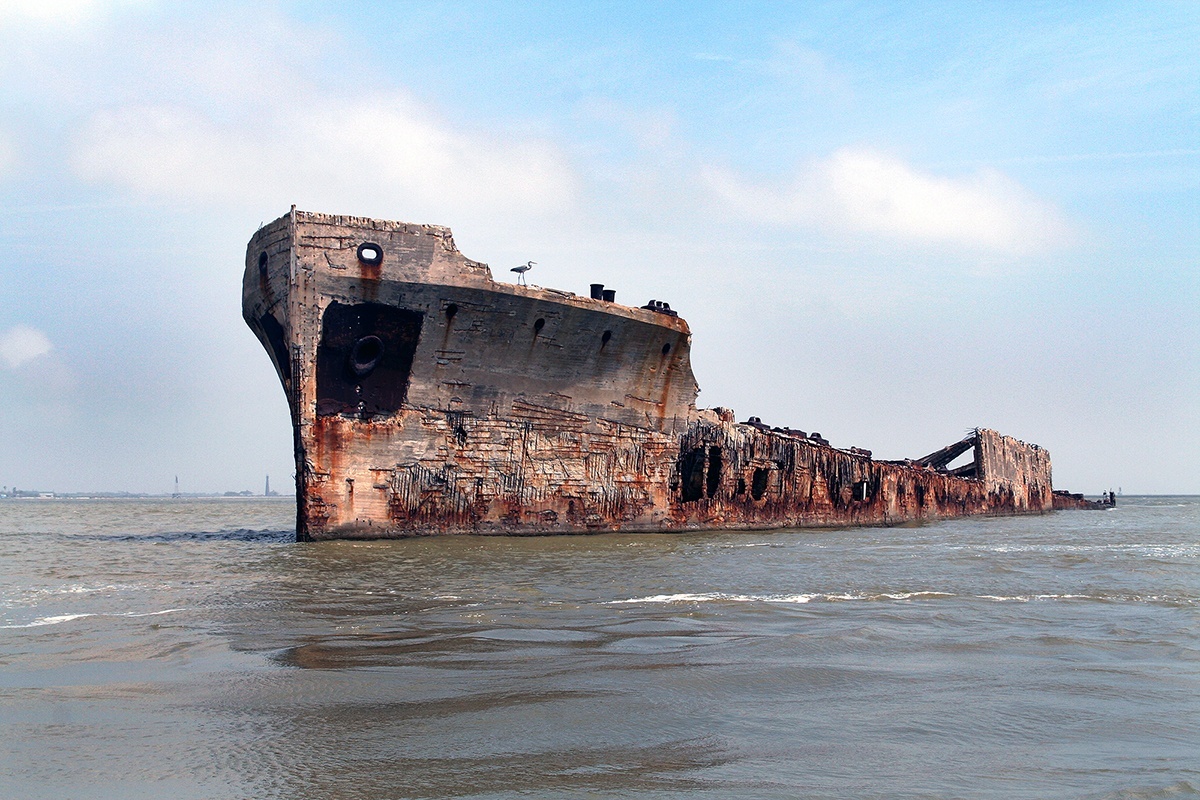In the old gangster films, a mafia figure who got crosswise with another boss might find himself wearing “concrete shoes” and tossed into the river to “sleep with the fishes.” With that legend in mind, it is surprising to note that concrete was once successfully used as a building material for the hulls of ships. One such vessel, the SS Selma, remains partially submerged in Galveston Bay and now is recognized as an archaeological landmark.
From the early days of shipbuilding until the mid-19th century, wood was the material of choice for seagoing vessels. The advent of steam propulsion fueled a desire to find improved shipbuilding materials, and the first iron ship, Aaron Manby, was built in London in 1821.
Iron sinks, but iron ships displaced water, and were lighter and stronger than wooden ships.
Shipbuilders preferred steel for large vessels because it was very strong for its weight. But when the supply of steel for ships fell short during World War I, President Woodrow Wilson approved the Emergency Fleet program that called for the construction of 24 concrete ships. None were completed before the end of the war, but 12 ships eventually were built. Although they stayed afloat, most sailors referred to them as “floating tombstones” and preferred not to serve on them.
A ship with a concrete hull floats as long as the weight of the water it displaces is greater than its own weight. The density of an object is the mass divided by the volume, so the weight of the hull and the air or cargo inside it (the total volume) had to be less than the water it displaced. British builders successfully experimented with concrete barges, tugs and fishing boats as early as 1917.
Flying in the face of logic, there were advantages to concrete ships, according to N.K. Fougner in the 1922 book Seagoing and Other Concrete Ships. They were cheaper to build, cost less in upkeep and were less subject to vibration from engines. More quickly and cheaply repaired than steel ships, they were fireproof and not subject to corrosion. Of course, steel reinforcing rods were necessary inside the concrete hull to give it strength.
Some of the American concrete ships completed after World War I were dispatched to transport troops home from Europe and then sold to private companies. When steel became more abundant, the concrete ships proved too expensive to operate—requiring huge amounts of fuel to push their heavy hulls through the surf. The largest two were sister ships, identical oil tankers a bit over 400 feet long: the SS Latham and the SS Selma. The Latham struck a jetty on the way back from its maiden voyage between Tampa and Philadelphia and limped into Galveston for repairs. Eventually, it became a floating oil tank near New Orleans.
The Selma performed more impressively, serving several coastal ports until it, too, hit a jetty, outside Tampico, Mexico, and suffered a 60-foot crack in its side. It was towed back to Galveston for repairs, but no one knew how to repair a long crack in a concrete ship, so it languished in Galveston harbor until 1922, when officials decided to scuttle it. Galveston Bay was too shallow, and sinking it there would cause a hazard to marine traffic. The Selma was towed into a trench 1,500 feet long and 25 feet deep dug on a shallow shelf off Pelican Island, where it is still visible today. It rests near the “marine battleground” where the Civil War’s Battle of Galveston occurred in 1863 and is clearly visible from the Bolivar Ferry.
That move did not signal the end of the Selma’s usefulness, however. Its career as a wreck is more exciting than its seagoing history. In 1926, it was used to store explosives. (Residents who considered the derelict ship an eyesore suggested that the dynamite stored in its hull be used to blow it up.) In 1928, an oil exploration company used it as a work staging area. During Prohibition, U.S. Customs inspectors smashed at least 11,000 bottles of bootleg liquor in its hold, much to the chagrin of a major smuggling ring doing big business along the Gulf Coast.
In 1992, the Texas Antiquities Committee designated the Selma a State Archeological Landmark and named it the Official Flagship of the Texas Army. All this praise was confirmed with an official Texas Historical Marker. It is listed on the National Register of Historic Places. From 1992 until his death in 2011, A. Pat Daniels, owner of the Selma and retired city editor of the Galveston Daily News, threw a birthday party for the old vessel.
——————–
Martha Deeringer, a member of Heart of Texas EC, lives near McGregor.


